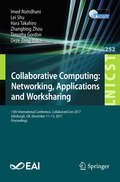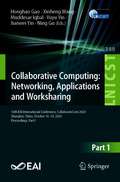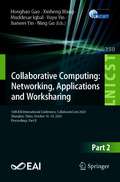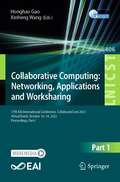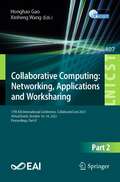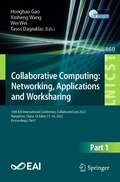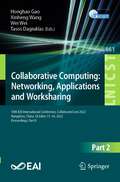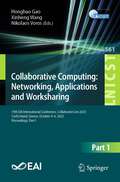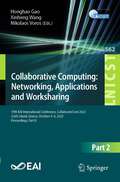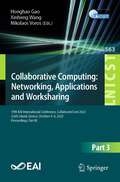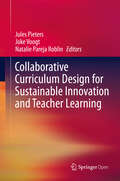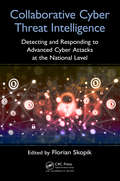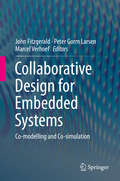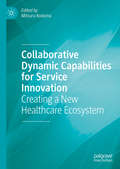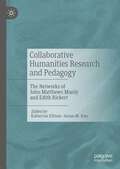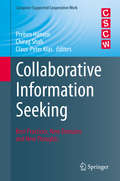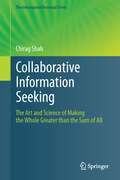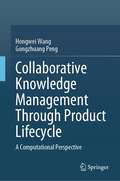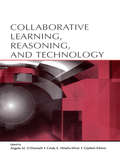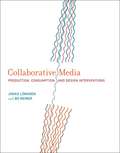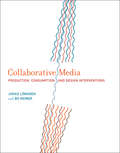- Table View
- List View
Collaborative Computing: 13th International Conference, CollaborateCom 2017, Edinburgh, UK, December 11–13, 2017, Proceedings (Lecture Notes of the Institute for Computer Sciences, Social Informatics and Telecommunications Engineering #252)
by Deze Zeng Lei Shu Imed Romdhani Hara Takahiro Zhangbing Zhou Timothy GordonThis book constitutes the thoroughly refereed proceedings of the 13th International Conference on Collaborative Computing: Networking, Applications, and Worksharing, CollaborateCom 2017, held in Edinburgh, UK, in December 2017. The 65 papers presented were carefully reviewed and selected from 103 submissions and focus on electronic collaboration between distributed teams of humans, computer applications, and autonomous robots to achieve higher productivity and produce joint products.
Collaborative Computing: 16th EAI International Conference, CollaborateCom 2020, Shanghai, China, October 16–18, 2020, Proceedings, Part I (Lecture Notes of the Institute for Computer Sciences, Social Informatics and Telecommunications Engineering #349)
by Honghao Gao Jianwei Yin Xinheng Wang Yuyu Yin Muddesar Iqbal Ning GuThis two-volume set constitutes the refereed proceedings of the 16th International Conference on Collaborative Computing: Networking, Applications, and Worksharing, CollaborateCom 2020, held in Shanghai, China, in October 2020.The 61 full papers and 16 short papers presented were carefully reviewed and selected from 211 submissions. The papers reflect the conference sessions as follows: Collaborative Applications for Network and E-Commerce; Optimization for Collaborate System; Cloud and Edge Computing; Artificial Intelligence; AI Application and Optimization; Classification and Recommendation; Internet of Things; Collaborative Robotics and Autonomous Systems; Smart Transportation.
Collaborative Computing: 16th EAI International Conference, CollaborateCom 2020, Shanghai, China, October 16–18, 2020, Proceedings, Part II (Lecture Notes of the Institute for Computer Sciences, Social Informatics and Telecommunications Engineering #350)
by Honghao Gao Jianwei Yin Xinheng Wang Yuyu Yin Muddesar Iqbal Ning GuThis two-volume set constitutes the refereed proceedings of the 16th International Conference on Collaborative Computing: Networking, Applications, and Worksharing, CollaborateCom 2020, held in Shanghai, China, in October 2020.The 61 full papers and 16 short papers presented were carefully reviewed and selected from 211 submissions. The papers reflect the conference sessions as follows: Collaborative Applications for Network and E-Commerce; Optimization for Collaborate System; Cloud and Edge Computing; Artificial Intelligence; AI Application and Optimization; Classification and Recommendation; Internet of Things; Collaborative Robotics and Autonomous Systems; Smart Transportation.
Collaborative Computing: 17th EAI International Conference, CollaborateCom 2021, Virtual Event, October 16-18, 2021, Proceedings, Part I (Lecture Notes of the Institute for Computer Sciences, Social Informatics and Telecommunications Engineering #406)
by Honghao Gao Xinheng WangThis two-volume set constitutes the refereed proceedings of the 17th International Conference on Collaborative Computing: Networking, Applications, and Worksharing, CollaborateCom 2021, held in October 2021. Due to COVID-19 pandemic the conference was held virtually.The 62 full papers and 7 short papers presented were carefully reviewed and selected from 206 submissions. The papers reflect the conference sessions as follows: Optimization for Collaborate System; Optimization based on Collaborative Computing; UVA and Traffic system; Recommendation System; Recommendation System & Network and Security; Network and Security; Network and Security & IoT and Social Networks; IoT and Social Networks & Images handling and human recognition; Images handling and human recognition & Edge Computing; Edge Computing; Edge Computing & Collaborative working; Collaborative working & Deep Learning and application; Deep Learning and application; Deep Learning and application; Deep Learning and application & UVA.
Collaborative Computing: 17th EAI International Conference, CollaborateCom 2021, Virtual Event, October 16-18, 2021, Proceedings, Part II (Lecture Notes of the Institute for Computer Sciences, Social Informatics and Telecommunications Engineering #407)
by Honghao Gao Xinheng WangThis two-volume set constitutes the refereed proceedings of the 17th International Conference on Collaborative Computing: Networking, Applications, and Worksharing, CollaborateCom 2021, held in October 2021. Due to COVID-19 pandemic the conference was held virtually.The 62 full papers and 7 short papers presented were carefully reviewed and selected from 206 submissions. The papers reflect the conference sessions as follows: Optimization for Collaborate System; Optimization based on Collaborative Computing; UVA and Traffic system; Recommendation System; Recommendation System & Network and Security; Network and Security; Network and Security & IoT and Social Networks; IoT and Social Networks & Images handling and human recognition; Images handling and human recognition & Edge Computing; Edge Computing; Edge Computing & Collaborative working; Collaborative working & Deep Learning and application; Deep Learning and application; Deep Learning and application; Deep Learning and application & UVA.
Collaborative Computing: 18th EAI International Conference, CollaborateCom 2022, Hangzhou, China, October 15-16, 2022, Proceedings, Part I (Lecture Notes of the Institute for Computer Sciences, Social Informatics and Telecommunications Engineering #460)
by Wei Wei Tasos Dagiuklas Honghao Gao Xinheng WangThe two-volume set LNICST 460 and 461 constitutes the proceedings of the 18th EAI International Conference on Collaborative Computing: Networking, Applications and Worksharing, CollaborateCom 2022, held in Hangzhou, China, in October 2022. The 57 full papers presented in the proceedings were carefully reviewed and selected from 171 submissions. The papers are organized in the following topical sections: Recommendation System; Federated Learning and application; Edge Computing and Collaborative working; Blockchain applications; Security and Privacy Protection; Deep Learning and application; Collaborative working; Images processing and recognition.
Collaborative Computing: 18th EAI International Conference, CollaborateCom 2022, Hangzhou, China, October 15-16, 2022, Proceedings, Part II (Lecture Notes of the Institute for Computer Sciences, Social Informatics and Telecommunications Engineering #461)
by Wei Wei Tasos Dagiuklas Honghao Gao Xinheng WangThe two-volume set LNICST 460 and 461 constitutes the proceedings of the 18th EAI International Conference on Collaborative Computing: Networking, Applications and Worksharing, CollaborateCom 2022, held in Hangzhou, China, in October 2022. The 57 full papers presented in the proceedings were carefully reviewed and selected from 171 submissions. The papers are organized in the following topical sections: Recommendation System; Federated Learning and application; Edge Computing and Collaborative working; Blockchain applications; Security and Privacy Protection; Deep Learning and application; Collaborative working; Images processing and recognition.
Collaborative Computing: 19th EAI International Conference, CollaborateCom 2023, Corfu Island, Greece, October 4-6, 2023, Proceedings, Part I (Lecture Notes of the Institute for Computer Sciences, Social Informatics and Telecommunications Engineering #561)
by Nikolaos Voros Honghao Gao Xinheng WangThe three-volume set LNICST 561, 562 563 constitutes the refereed post-conference proceedings of the 19th EAI International Conference on Collaborative Computing: Networking, Applications and Worksharing, CollaborateCom 2023, held in Corfu Island, Greece, during October 4-6, 2023.The 72 full papers presented in these proceedings were carefully reviewed and selected from 176 submissions. The papers are organized in the following topical sections:Volume I : Collaborative Computing, Edge Computing & Collaborative working, Blockchain applications, Code Search and Completion, Edge Computing Scheduling and Offloading.Volume II: Deep Learning and Application, Graph Computing, Security and Privacy Protection and Processing and Recognition.Volume III: Onsite Session Day 2, Federated learning and application, Collaborative working, Edge Computing and Prediction, Optimization and Applications.
Collaborative Computing: 19th EAI International Conference, CollaborateCom 2023, Corfu Island, Greece, October 4-6, 2023, Proceedings, Part II (Lecture Notes of the Institute for Computer Sciences, Social Informatics and Telecommunications Engineering #562)
by Nikolaos Voros Honghao Gao Xinheng WangThe three-volume set LNICST 561, 562 563 constitutes the refereed post-conference proceedings of the 19th EAI International Conference on Collaborative Computing: Networking, Applications and Worksharing, CollaborateCom 2023, held in Corfu Island, Greece, during October 4-6, 2023.The 72 full papers presented in these proceedings were carefully reviewed and selected from 176 submissions. The papers are organized in the following topical sections:Volume I : Collaborative Computing, Edge Computing & Collaborative working, Blockchain applications, Code Search and Completion, Edge Computing Scheduling and Offloading.Volume II: Deep Learning and Application, Graph Computing, Security and Privacy Protection and Processing and Recognition.Volume III: Onsite Session Day 2, Federated learning and application, Collaborative working, Edge Computing and Prediction, Optimization and Applications.
Collaborative Computing: 19th EAI International Conference, CollaborateCom 2023, Corfu Island, Greece, October 4-6, 2023, Proceedings, Part III (Lecture Notes of the Institute for Computer Sciences, Social Informatics and Telecommunications Engineering #563)
by Nikolaos Voros Honghao Gao Xinheng WangThe three-volume set LNICST 561, 562 563 constitutes the refereed post-conference proceedings of the 19th EAI International Conference on Collaborative Computing: Networking, Applications and Worksharing, CollaborateCom 2023, held in Corfu Island, Greece, during October 4-6, 2023.The 72 full papers presented in these proceedings were carefully reviewed and selected from 176 submissions. The papers are organized in the following topical sections:Volume I : Collaborative Computing, Edge Computing & Collaborative working, Blockchain applications, Code Search and Completion, Edge Computing Scheduling and Offloading.Volume II: Deep Learning and Application, Graph Computing, Security and Privacy Protection and Processing and Recognition.Volume III: Onsite Session Day 2, Federated learning and application, Collaborative working, Edge Computing and Prediction, Optimization and Applications.
Collaborative Curriculum Design for Sustainable Innovation and Teacher Learning
by Joke Voogt Jules Pieters Natalie Pareja RoblinThis open access book provides insight into what it takes to actively involve teachers in the curriculum design process. It examines different aspects of teacher involvement in collaborative curriculum design, with specific attention to its implications for sustainable curriculum innovation and teacher learning. Divided into six sections, the book starts out by introducing the notion of collaborative curriculum design and discusses its historical and theoretical foundations. It describes various approaches commonly adopted to actively involve teachers in the (co-)design of curriculum materials. Sections two and three provide examples of what key phases in the curriculum design process - such as needs analysis, design and development, and implementation - look like across various collaborative curriculum design projects. Section four reports on the impact of collaborative curriculum design on student learning, teacher practices, teacher professional growth, and institutional change. Building on the research evidence about the outcomes of collaborative curriculum design, section five focuses on sustainability, scaling-up and curriculum leadership issues, which are key to the continuation and further evolution of curriculum innovations. Future perspectives are addressed in section six with emphasis on the infrastructure of a sustainable curriculum innovation.
Collaborative Cyber Threat Intelligence: Detecting and Responding to Advanced Cyber Attacks at the National Level
by Florian SkopikThreat intelligence is a surprisingly complex topic that goes far beyond the obvious technical challenges of collecting, modelling and sharing technical indicators. Most books in this area focus mainly on technical measures to harden a system based on threat intel data and limit their scope to single organizations only. This book provides a unique angle on the topic of national cyber threat intelligence and security information sharing. It also provides a clear view on ongoing works in research laboratories world-wide in order to address current security concerns at national level. It allows practitioners to learn about upcoming trends, researchers to share current results, and decision makers to prepare for future developments.
Collaborative Design for Embedded Systems: Co-modelling and Co-simulation
by John Fitzgerald Peter Gorm Larsen Marcel VerhoefOne of the most significant challenges in the development of embedded and cyber-physical systems is the gap between the disciplines of software and control engineering. In a marketplace, where rapid innovation is essential, engineers from both disciplines need to be able to explore system designs collaboratively, allocating responsibilities to software and physical elements, and analyzing trade-offs between them. To this end, this book presents a framework that allows the very different kinds of design models - discrete-event (DE) models of software and continuous time (CT) models of the physical environment - to be analyzed and simulated jointly, based on common scenarios. The individual chapters provide introductions to both sides of this co-simulation technology, and give a step-by-step guide to the methodology for designing and analyzing co-models. They are grouped into three parts: Part I introduces the technical basis for collaborative modeling and simulation with the Crescendo technology. Part II continues with different methodological guidelines for creating co-models and analyzing them in different ways using case studies. Part III then delves into more advanced topics and looks into the potential future of this technology in the area of cyber-physical systems. Finally various appendices provide summaries of the VDM and 20-sim technologies, a number of valuable design patterns applicable for co-models, and an acronym list along with indices and references to other literature. By combining descriptions of the underlying theory with records of real engineers' experience in using the framework on a series of case studies the book appeals to scientists and practitioners alike. It is complemented by tools, examples, videos, and other material on www. crescendotool. org. Scientists/researchers and graduate students working in embedded and cyber-physical systems will learn the semantic foundations for collaborative modeling and simulation, as well as the current capabilities and limitations of methods and tools in this field. Practitioners will be able to develop an appreciation of the capabilities of the co-modeling techniques, to assess the benefits of more collaborative approaches to modeling and simulation, and will benefit from the included guidelines and modeling patterns.
Collaborative Dynamic Capabilities for Service Innovation: Creating a New Healthcare Ecosystem
by Mitsuru KodamaExploring the theoretical concept of collaborative dynamic capabilities, this book illustrates how service innovation can be achieved in an era of technological convergence. Focusing on e-healthcare systems within hospitals and private businesses, the author provides detailed case studies and answers topical questions about generating service innovation across different industries. Making a new and thought-provoking contribution to research on innovation and technology management, this useful book engages with theory and provides applicable solutions for practitioners to implement in the future.
Collaborative Financial Infrastructure Protection: Tools, Abstractions, and Middleware
by Gregory Chockler Roberto BaldoniThe Critical Infrastructure Protection Survey recently released by Symantec found that 53% of interviewed IT security experts from international companies experienced at least ten cyber attacks in the last five years, and financial institutions were often subject to some of the most sophisticated and large-scale cyber attacks and frauds. The book by Baldoni and Chockler analyzes the structure of software infrastructures found in the financial domain, their vulnerabilities to cyber attacks and the existing protection mechanisms. It then shows the advantages of sharing information among financial players in order to detect and quickly react to cyber attacks. Various aspects associated with information sharing are investigated from the organizational, cultural and legislative perspectives. The presentation is organized in two parts: Part I explores general issues associated with information sharing in the financial sector and is intended to set the stage for the vertical IT middleware solution proposed in Part II. Nonetheless, it is self-contained and details a survey of various types of critical infrastructure along with their vulnerability analysis, which has not yet appeared in a textbook-style publication elsewhere. Part II then presents the CoMiFin middleware for collaborative protection of the financial infrastructure. The material is presented in an accessible style and does not require specific prerequisites. It appeals to both researchers in the areas of security, distributed systems, and event processing working on new protection mechanisms, and practitioners looking for a state-of-the-art middleware technology to enhance the security of their critical infrastructures in e.g. banking, military, and other highly sensitive applications. The latter group will especially appreciate the concrete usage scenarios included.
Collaborative Humanities Research and Pedagogy: The Networks of John Matthews Manly and Edith Rickert
by Katherine Ellison Susan M. KimThis edited collection of essays brings together scholars across disciplines who consider the collaborative work of John Matthews Manly and Edith Rickert, philologists, medievalists and early modernists, cryptologists, and education reformers. These pioneers crafted interdisciplinary partnerships as they modeled and advocated for cooperative alliances at every level of their work and in all their academic relationships. Their extensive network of intellectual partnerships made possible groundbreaking projects, from the eight-volume Text of the Canterbury Tales (1940) to the deciphering of the Waberski Cipher, yet, except for their Chaucer work, their many other accomplishments have received little attention. Collaborative Humanities Research and Pedagogy not only surveys the rich range of their work but also emphasizes the transformative intellectual and pedagogical benefits of collaboration.
Collaborative Information Seeking: Best Practices, New Domains and New Thoughts (Computer Supported Cooperative Work #34)
by Preben Hansen Chirag Shah Claus-Peter KlasCompiled by world- class leaders in the field of collaborative information retrieval and search (CIS), this book centres on the notion that information seeking is not always a solitary activity and working in collaboration to perform information-seeking tasks should be studied and supported. Covering aspects of theories, models, and applications the book is divided in three parts: · Best Practices and Studies: providing an overview of current knowledge and state-of-the-art in the field. · New Domains: covers some of the new and exciting opportunities of applying CIS · New Thoughts: focuses on new research directions by scholars from academia and industry from around the world. Collaborative Information Seeking provides a valuable reference for student, teachers, and researchers interested in the area of collaborative work, information seeking/retrieval, and human-computer interaction.
Collaborative Information Seeking: The Art and Science of Making the Whole Greater than the Sum of All (The Information Retrieval Series #34)
by Chirag ShahToday's complex, information-intensive problems often require people to work together. Mostly these tasks go far beyond simply searching together; they include information lookup, sharing, synthesis, and decision-making. In addition, they all have an end-goal that is mutually beneficial to all parties involved. Such "collaborative information seeking" (CIS) projects typically last several sessions and the participants all share an intention to contribute and benefit. Not surprisingly, these processes are highly interactive. Shah focuses on two individually well-understood notions: collaboration and information seeking, with the goal of bringing them together to show how it is a natural tendency for humans to work together on complex tasks. The first part of his book introduces the general notions of collaboration and information seeking, as well as related concepts, terminology, and frameworks; and thus provides the reader with a comprehensive treatment of the concepts underlying CIS. The second part of the book details CIS as a standalone domain. A series of frameworks, theories, and models are introduced to provide a conceptual basis for CIS. The final part describes several systems and applications of CIS, along with their broader implications on other fields such as computer-supported cooperative work (CSCW) and human-computer interaction (HCI). With this first comprehensive overview of an exciting new research field, Shah delivers to graduate students and researchers in academia and industry an encompassing description of the technologies involved, state-of-the-art results, and open challenges as well as research opportunities.
Collaborative Innovation Networks: Latest Insights from Social Innovation, Education, and Emerging Technologies Research (Studies on Entrepreneurship, Structural Change and Industrial Dynamics)
by João Leitão Peter A. Gloor Francesca Grippa Yang SongCollaborative innovation networks are cyberteams of motivated individuals, and are self-organizing emergent social systems with the potential to promote health, happiness and individual growth in real-world work settings.This book describes how to identify and nurture collaborative innovation networks in order to shape the future working environment and pave the way for health and happiness, and how to develop future technologies to promote economic development, social innovation and entrepreneurship. The expert contributions and case studies presented also offer insights into how large corporations can creatively generate solutions to real-world problems by means of self-organizing mechanisms, while simultaneously promoting the well-being of individual workers. The book also discusses how such networks can benefit startups, offering new self-organizing forms of leadership in which all stakeholders are encouraged to collaborate in the development of new products.
Collaborative Intelligence: How Humans and AI Are Transforming Our World
by Mira Lane and Arathi SethumadhavanA deep look into the multifaceted landscape of artificial intelligence, considering AI&’s ethical and societal implications and celebrating its diverse and innovative applications.In this edited collection Collaborative Intelligence, Mira Lane and Arathi Sethumadhavan embark on a captivating exploration of artificial intelligence. The book delves deeply into the dynamic interplay between theory and practice, shedding light on the transformative potential and complexities of AI. For practitioners deeply immersed in the world of AI, Lane and Sethumadhavan offer firsthand accounts and insights from technologists, academics, and thought leaders, as well as a series of compelling case studies, ranging from AI's impact on artistry to its role in addressing societal challenges like modern slavery and wildlife conservation.As the global AI market burgeons, this book enables collaboration, knowledge sharing, and interdisciplinary dialogue. It caters not only to the practitioners shaping the AI landscape but also to policymakers striving to navigate the intricate relationship between humans and machines, as well as academics. Divided into two parts, the first half of the book offers readers a comprehensive understanding of AI's historical context, its influence on power dynamics, human-AI interaction, and the critical role of audits in governing AI systems. The second half unfolds a series of eight case studies, unraveling AI&’s impact on fields as varied as healthcare, vehicular safety, conservation, human rights, and the metaverse. Each chapter in this book paints a vivid picture of AI&’s triumphs and challenges, providing a panoramic view of how it is reshaping our world.
Collaborative Knowledge Management Through Product Lifecycle: A Computational Perspective
by Hongwei Wang Gongzhuang PengThis book not only presents the state-of-the-art research on knowledge modelling, knowledge retrieval and knowledge reuse, but also elaborates the Collaborative Knowledge Management (CKM) paradigm and the architecture for the next generation of knowledge management systems. Although knowledge management has been extensively studied, particularly in the fields of business management and engineering design, there is a lack of systematic methodologies for addressing the integrated and collaborative dimension of knowledge management during the collaborative process of designing and developing complex systems, products, processes and services. The rapid development of information technologies, together with their applications in engineering and management, has laid the foundation for a Collaborative Knowledge Management (CKM) paradigm. The book specifically discusses this paradigm from a computational perspective. By exploring specific research findings underpinning further CKM research and applications and describing methods related to hot research topics and new research areas, the book appeals to professionals, researchers and graduate students who are interested in knowledge management and related topics and who have a basic understanding of information technologies, computational methods, and knowledge management.
Collaborative Learning, Reasoning, and Technology (Rutgers Invitational Symposium On Education Ser.)
by Gijsbert Erkens Cindy E. Hmelo-Silver Angela M. O’DonnellThis volume presents research findings on the use of technology to support learning and reasoning in collaborative contexts. Featuring a variety of theoretical perspectives, ranging from sociocultural to social psychological to information processing views, Collaborative Learning, Reasoning, and Technology includes an international group of authors
Collaborative Manufacturing: Using Real-Time Information to Support the Supply Chain (Resource Management)
by Michael McClellanCollaborative manufacturing is an interactive process with great potential, but without the direct input of the plant floor systems information, a significant piece of the management process is not available for consideration. Collaborative Manufacturing provides guidance and examples of how and why real-time events within the plant floor managemen
Collaborative Media: Production, Consumption, and Design Interventions
by Jonas Löwgren Bo ReimerWith many new forms of digital media--including such popular social media as Facebook, Twitter, and Flickr -- the people formerly known as the audience no longer only consume but also produce and even design media. Jonas L'wgren and Bo Reimer term this phenomenon collaborative media, and in this book they investigate the qualities and characteristics of these forms of media in terms of what they enable people to do. They do so through an interdisciplinary research approach that combines the social sciences and humanities traditions of empirical and theoretical work with practice-based, design-oriented interventions. L'wgren and Reimer offer analysis and a series of illuminating case studies -- examples of projects in collaborative media that range from small multidisciplinary research experiments to commercial projects used by millions of people. L'wgren and Reimer discuss the case studies at three levels of analysis: society and the role of collaborative media in societal change; institutions and the relationship of collaborative media with established media structures; and tribes, the nurturing of small communities within a large technical infrastructure. They conclude by advocating an interventionist turn within social analysis and media design.
Collaborative Media: Production, Consumption, and Design Interventions (The\mit Press Ser.)
by Bo Reimer Jonas LowgrenA thorough analysis of contemporary digital media practices, showing how people increasingly not only consume but also produce and even design media. With many new forms of digital media–including such popular social media as Facebook, Twitter, and Flickr—the people formerly known as the audience no longer only consume but also produce and even design media. Jonas Löwgren and Bo Reimer term this phenomenon collaborative media, and in this book they investigate the qualities and characteristics of these forms of media in terms of what they enable people to do. They do so through an interdisciplinary research approach that combines the social sciences and humanities traditions of empirical and theoretical work with practice-based, design-oriented interventions. Löwgren and Reimer offer analysis and a series of illuminating case studies—examples of projects in collaborative media that range from small multidisciplinary research experiments to commercial projects used by millions of people. Löwgren and Reimer discuss the case studies at three levels of analysis: society and the role of collaborative media in societal change; institutions and the relationship of collaborative media with established media structures; and tribes, the nurturing of small communities within a large technical infrastructure. They conclude by advocating an interventionist turn within social analysis and media design.
